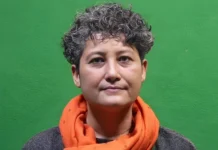NEW DELHI, 21 Oct: The artworks of Behelti Ama, a senior volunteer of the Lohit Youth Library Movement, brought laurels to Arunachal Pradesh for the second consecutive year at the Tribal Art Exhibition, which was held here from 17 to 19 October.
The second edition of the four-day exhibition, ‘Silent conversation: From margins to the centre’ was inaugurated by External Affairs Minister Dr S Jaishankar at the India Habitat Centre here. It was organized by the National Tiger Conservation Authority, in collaboration with the Sankala Foundation, the National Human Rights Commission, and the International Big Cat Alliance, Lohit Youth Library Network coordinator S Mundayoor said in a release.
Dr Jaishankar, who went through the exhibition keenly, heartily appreciated the artworks of Behelti, “after patiently listening to my explanations of my artworks,” said a grateful Behelti.
Union Culture & Tourism Minister Dr Gajendra Singh Shekhawat also went round the art exhibits with great interest.
Referring to his friendly interactions, Behelti Ama said, “When I told him that the Mishmi tribe does not have tribal art styles like Gond, Varli, Mahbubani, etc, but as an art student I am learning different styles and trying my best to depict my culture through my art, Dr Shekhawat quipped: ‘Maybe in future this type of art will be known as Behelti Art!'”
Speaking about the exhibition, she said that every artist who came had a unique style of painting, and the concept of depicting tigers in their paintings in their own way was really impressive.
“At the exhibition, I came to know how tigers have an important role in their lives. These beliefs somehow also help the tiger reserves in some ways to protect tigers,” she said.
Speaking on her education as an artist at the reputed Kalakshetra Foundation, Chennai, Behelti Ama said that there is so much more to learn. She advised upcoming Arunachali artists to keep learning different styles and mediums, so that they could one day create their own style of art.
Ama thanked Kamlang Tiger Reserve DCF Jumdo Geiyi for encouraging and supporting her to participate in the art exhibition.
The Tribal Art Exhibition aims to recognize the conservation ethos of tribal communities and highlight the symbiotic relationship between these communities and the environment. It seeks to inspire future generations to appreciate this connection and provides tribal artists an opportunity to engage with visitors. Their artworks were made available for sale, with proceeds directly benefiting the artisans.
The exhibition featured over 200 paintings and 100 art pieces from 49 artists from 22 tiger reserves across India. All artworks were crafted using sustainable materials, reflecting the eco-friendly lifestyle of indigenous communities.




